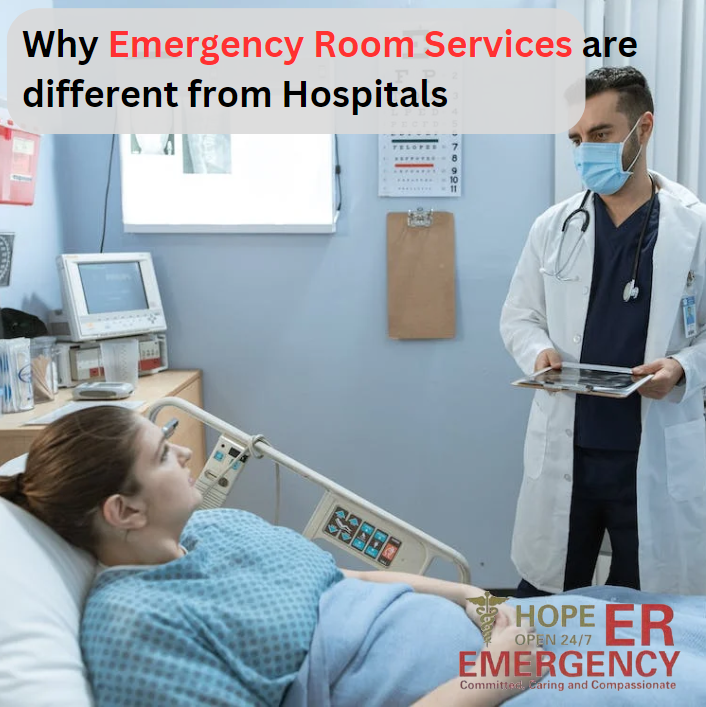Emergency room services and hospitals are closely related, but they serve different purposes within the broader healthcare system. Let’s take a look at the key differences between the two:
Function and Purpose:
Emergency Room (ER): The ER, also known as the emergency department (ED), is a specialized area within a hospital designed to provide immediate medical care to patients with acute and life-threatening conditions. These conditions may include severe injuries, critical illnesses, or other medical emergencies that require prompt attention.
Hospitals: Hospitals are healthcare facilities that offer a wide range of medical services, including emergency care, but their primary function is to provide ongoing medical care, treatment, surgery, diagnostic services, and inpatient care. Hospitals have various departments and units, such as the ER, operating rooms, labor and delivery, intensive care units (ICUs), and general medical and surgical units.
Scope of Services:
ER: The ER is focused on triaging and stabilizing patients in critical condition. It provides initial assessment, resuscitation, and immediate care. Once a patient is stable, they may be admitted to the hospital or discharged, depending on the severity of their condition.
Hospitals: Hospitals offer a wide range of medical services, including routine and elective medical care, surgeries, diagnostic tests, long-term treatment, and follow-up care. Hospitals can admit patients for extended stays, and they have specialized departments and equipment for various medical specialties.
Staffing:
ER: ERs are staffed with healthcare professionals trained to handle emergencies, including emergency physicians, nurses, and support staff. They are prepared to work under high-pressure situations and make quick decisions.
Hospitals: Hospitals employ a diverse range of medical professionals, including general practitioners, specialists, surgeons, nurses, and other healthcare workers. The staffing in hospitals is tailored to provide comprehensive and ongoing care for patients with various medical needs.
Hours of Operation:
ER: Emergency rooms are typically open 24/7, as medical emergencies can occur at any time. They are always available to provide immediate care.
Hospitals: Hospitals operate 24/7 as well, but their services extend beyond emergency care. They provide ongoing care, which means that various hospital departments and services may operate on different schedules.
Location:
ER: The emergency room is a specific area within a hospital, typically located near the hospital’s main entrance for easy access.
Hospitals: Hospitals are larger healthcare facilities with multiple departments and services. They may consist of multiple buildings or be part of a larger medical campus.
In summary, emergency room services are a critical component of hospitals, but they serve a distinct and essential role in addressing medical emergencies. Hospitals offer a broader range of medical services, including inpatient and outpatient care, and they are equipped to handle various medical conditions beyond emergencies.
Hope ER is one such emergency room with the stringent TX State requirements that are applicable to the Hospitals. Hope ER can do an observation admission for up to 23 hours and has a transfer agreement with a local hospital wherein the patient can be moved, as needed. It could be an accident or a sudden trauma that has bleeding wounds or could be a chronic condition that needs immediate medical attention. You may contact Hope ER for Emergency Medical Services in Lufkin at 2111 East Denman Avenue, Lufkin TX 7591, and can be reached @ 936-899-7243. Our website is www.hopeer911.com
